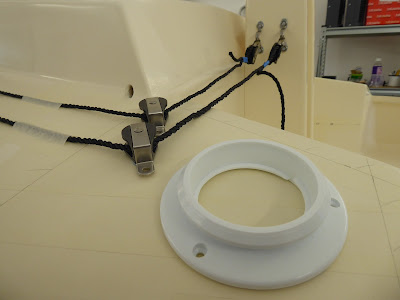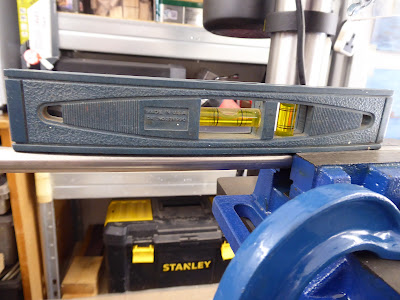I needed to install 12mm pivot eyes on the hull and the rudder, to hold the pivot rod.
The build manual tells us to screw the eyes into the solid timber of the rudder and the keel, using un-thickened epoxy resin to glue them in place. The hole needs to be slightly smaller than the diameter of the eye's machine screw to allow a thread to be cut in the wood.
I drilled some holes in a piece of scrap Ash to check how much smaller the hole needs to be, and test fitted an eye. Like this.
The 6mm machine screw thread needs a 5.5mm hole to screw into.The first thing I did was to mark up and drill a 6mm hole in the transom, for the upper eye on the hull. This is it.
A quick test fit followed. It looked OK.
Unlike the other three eyes this one is a through hull fitting, secured with a dome nut inside the transom. So it has to be exactly the right length.Here I am measuring how much of the machine screw I need to cut off.
My next task was to drill a 5.5mm hole in the bottom of the keel for the lower eye.I marked it up, picked up the drill and made a hole. I immediately realised that it was still fitted with the 6mm bit.
So, I plugged the hole and started again.
This time I drilled the 5.5mm hole at the wrong angle, so the eye would not fit correctly.
So again, I plugged the hole with some dowel and epoxy resin. Here it is.
Third time lucky? To minimise the amount of luck required I marked up the required angle on the keel, like this.This helped enormously and I was able to drill a perfect hole.Now, the manual says to use epoxy resin to secure the eyes but I had a lot of 3M 5200 adhesive sealant left over from the bow eye installation.
This stuff is supposed to be a permanent as well as waterproof bond, and I thought that would be better. So I used it instead.
It worked really well. The sealant acted as a lubricant when screwing in the eye, and it was an easy job.
Here I am installing the eye.
And here is the finished article.That looks OK.Finally, a quick test for the pivot rod. Here it is.
We are definitely getting there!














































